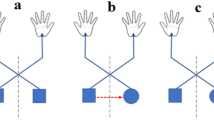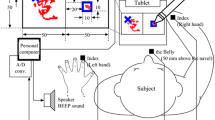Abstract
Experimental studies led by Lashley and Raibert in the early phase of human movement science highlighted the phenomenon of motor equivalence, according to which complex movements are represented in the brain abstractly, in a way that is independent of the effector used for the execution of the movement. This abstract representation is known as motor program and it defines the temporal sequence of target points the effector has to move towards to accomplish the desired movement. We present and compare two algorithms for the extraction of motor programs from handwriting samples. One algorithm considers that lognormal velocity profiles are an invariant characteristic of reaching movements and it identifies the position of the target points by analysing the velocity profile of samples. The other algorithm seeks target points by identifying the trajectory points corresponding to maximum curvature variations because experimental studies have shown that the activity of the primary motor cortex encodes the direction of the movement. We have compared the performance of the two algorithms in terms of the number of virtual target points extracted by handwriting samples generated by 32 subjects with their dominant and non-dominant hands. The results have shown that the two algorithms show a similar performance over \(\sim \)55% of samples but the extraction of motor programs by analysing the curvature variations is more robust to noise and unmodeled motor variability.
Access this chapter
Tax calculation will be finalised at checkout
Purchases are for personal use only
Similar content being viewed by others
References
Alstermark, B., Isa, T.: Circuits for skilled reaching and grasping. Annu. Rev. Neurosci. 35, 559–578 (2012)
Chen, S., Lach, J., Lo, B., Yang, G.Z.: Toward pervasive gait analysis with wearable sensors: a systematic review. IEEE J. Biomed. Health Inform. 20(6), 1521–1537 (2016)
Cilia, N.D., De Gregorio, G., De Stefano, C., Fontanella, F., Marcelli, A., Parziale, A.: Diagnosing alzheimer’s disease from on-line handwriting: a novel dataset and performance benchmarking. Eng. Appl. Artif. Intell. 111, 104822 (2022). https://doi.org/10.1016/j.engappai.2022.104822
De Stefano, C., Fontanella, F., Impedovo, D., Pirlo, G., di Freca, A.S.: Handwriting analysis to support neurodegenerative diseases diagnosis: a review. Pattern Recogn. Lett. 121, 37–45 (2019)
De Stefano, C., Guadagno, G., Marcelli, A.: A saliency-based segmentation method for online cursive handwriting. Int. J. Pattern Recognit. Artif. Intell. 18(07), 1139–1156 (2004)
Diaz, M., Ferrer, M.A., Parziale, A., Marcelli, A.: Recovering western on-line signatures from image-based specimens. In: 2017 14th IAPR International Conference on Document Analysis and Recognition (ICDAR), vol. 1, pp. 1204–1209. IEEE (2017)
Faundez-Zanuy, M., Fierrez, J., Ferrer, M.A., Diaz, M., Tolosana, R., Plamondon, R.: Handwriting biometrics: applications and future trends in e-security and e-health. Cogn. Comput. 12(5), 940–953 (2020). https://doi.org/10.1007/s12559-020-09755-z
Ferrer, M.A., Diaz, M., Carmona-Duarte, C., Plamondon, R.: iDeLog: iterative dual spatial and kinematic extraction of sigma-lognormal parameters. IEEE Trans. Pattern Anal. Mach. Intell. 42(1), 114–125 (2018)
Georgopoulos, A.P., Schwartz, A.B., Kettner, R.E.: Neuronal population coding of movement direction. Science 233(4771), 1416–1419 (1986)
Gerth, S., et al.: Is handwriting performance affected by the writing surface? comparing preschoolers’, second graders’, and adults’ writing performance on a tablet vs. paper. Front. Psychol. 7, 1308 (2016)
Herzfeld, D.J., Shadmehr, R.: Motor variability is not noise, but grist for the learning mill. Nat. Neurosci. 17(2), 149–150 (2014)
Huang, J., Zhang, Z.: A novel sigma-lognormal parameter extractor for online signatures. In: Lladós, J., Lopresti, D., Uchida, S. (eds.) ICDAR 2021. LNCS, vol. 12823, pp. 459–473. Springer, Cham (2021). https://doi.org/10.1007/978-3-030-86334-0_30
Liu, M., Guo, X., Wang, G.: Stroke parameters identification algorithm in handwriting movements analysis by synthesis. IEEE J. Biomed. Health Inform. 19(1), 317–324 (2014)
Marcelli, A., Parziale, A., Senatore, R.: Some observations on handwriting from a motor learning perspective. In: AFHA, vol. 1022, pp. 6–10. Citeseer (2013)
Morasso, P.: Spatial control of arm movements. Exp. Brain Res. 42(2), 223–227 (1981). https://doi.org/10.1007/BF00236911
O’Reilly, C., Plamondon, R.: Development of a sigma-lognormal representation for on-line signatures. Pattern Recogn. 42(12), 3324–3337 (2009)
Parziale, A., Carmona-Duarte, C., Ferrer, M.A., Marcelli, A.: 2D vs 3D online writer identification: a comparative study. In: Lladós, J., Lopresti, D., Uchida, S. (eds.) ICDAR 2021. LNCS, vol. 12823, pp. 307–321. Springer, Cham (2021). https://doi.org/10.1007/978-3-030-86334-0_20
Parziale, A., Diaz, M., Ferrer, M.A., Marcelli, A.: SM-DTW: stability modulated dynamic time warping for signature verification. Pattern Recogn. Lett. 121, 113–122 (2019)
Parziale, A., Parisi, R., Marcelli, A.: Extracting the motor program of handwriting from its lognormal representation. In: The Lognormality Principle and its Applications in E-security, E-learning And E-health, pp. 289–308. World Scientific (2021)
Parziale, A., Senatore, R., Della Cioppa, A., Marcelli, A.: Cartesian genetic programming for diagnosis of Parkinson disease through handwriting analysis: performance vs. interpretability issues. Artif. Intell. Med. 111, 101984 (2021)
Parziale, A., Senatore, R., Marcelli, A.: Exploring speed-accuracy tradeoff in reaching movements: a neurocomputational model. Neural Comput. Appl. 32(17), 13377–13403 (2020). https://doi.org/10.1007/s00521-019-04690-z
Plamondon, R.: A kinematic theory of rapid human movements: part i. movement representation and generation. Biol. Cybern. 72(4), 295–307 (1995)
Plamondon, R., Djioua, M.: A multi-level representation paradigm for handwriting stroke generation. Hum. Mov. Sci. 25(4–5), 586–607 (2006)
Prakash, C., Kumar, R., Mittal, N.: Recent developments in human gait research: parameters, approaches, applications, machine learning techniques, datasets and challenges. Artif. Intell. Rev. 49(1), 1–40 (2018). https://doi.org/10.1007/s10462-016-9514-6
Raibert, M.H.: Motor control and learning by the state space model. Ph.D. thesis, Massachusetts Institute of Technology (1977)
Reschechtko, S., Pruszynski, J.A.: Stretch reflexes. Curr. Biol. 30(18), R1025–R1030 (2020)
Senatore, R., Marcelli, A.: A neural scheme for procedural motor learning of handwriting. In: 2012 International Conference on Frontiers in Handwriting Recognition, pp. 659–664. IEEE (2012)
Summers, J.J., Anson, J.G.: Current status of the motor program: revisited. Hum. Mov. Sci. 28(5), 566–577 (2009)
Tucha, O., et al.: Kinematic analysis of dopaminergic effects on skilled handwriting movements in Parkinson’s disease. J. Neural Transm. 113(5), 609–623 (2006). https://doi.org/10.1007/s00702-005-0346-9
Ünlü, A., Brause, R., Krakow, K.: Handwriting analysis for diagnosis and prognosis of Parkinson’s disease. In: Maglaveras, N., Chouvarda, I., Koutkias, V., Brause, R. (eds.) ISBMDA 2006. LNCS, vol. 4345, pp. 441–450. Springer, Heidelberg (2006). https://doi.org/10.1007/11946465_40
Vahdat, S., Lungu, O., Cohen-Adad, J., Marchand-Pauvert, V., Benali, H., Doyon, J.: Simultaneous brain-cervical cord FMRI reveals intrinsic spinal cord plasticity during motor sequence learning. PLoS Biol. 13(6), e1002186 (2015)
Van Gemmert, A.W., Teulings, H.L., Stelmach, G.E.: Parkinsonian patients reduce their stroke size with increased processing demands. Brain Cogn. 47(3), 504–512 (2001)
Wang, C., Xiao, Y., Burdet, E., Gordon, J., Schweighofer, N.: The duration of reaching movement is longer than predicted by minimum variance. J. Neurophysiol. 116(5), 2342–2345 (2016)
Weiler, J., Gribble, P.L., Pruszynski, J.A.: Spinal stretch reflexes support efficient hand control. Nat. Neurosci. 22(4), 529–533 (2019)
Wing, A.M.: Motor control: mechanisms of motor equivalence in handwriting. Curr. Biol. 10(6), R245–R248 (2000)
Wolpaw, J.R.: The education and re-education of the spinal cord. Prog. Brain Res. 157, 261–399 (2006)
Wolpaw, J.R.: The negotiated equilibrium model of spinal cord function. J. Physiol. 596(16), 3469–3491 (2018)
Wolpaw, J.R., Tennissen, A.M.: Activity-dependent spinal cord plasticity in health and disease. Annu. Rev. Neurosci. 24(1), 807–843 (2001)
Author information
Authors and Affiliations
Corresponding author
Editor information
Editors and Affiliations
Rights and permissions
Copyright information
© 2022 Springer Nature Switzerland AG
About this paper
Cite this paper
Parziale, A., Marcelli, A. (2022). Should We Look at Curvature or Velocity to Extract a Motor Program?. In: Carmona-Duarte, C., Diaz, M., Ferrer, M.A., Morales, A. (eds) Intertwining Graphonomics with Human Movements. IGS 2022. Lecture Notes in Computer Science, vol 13424. Springer, Cham. https://doi.org/10.1007/978-3-031-19745-1_15
Download citation
DOI: https://doi.org/10.1007/978-3-031-19745-1_15
Published:
Publisher Name: Springer, Cham
Print ISBN: 978-3-031-19744-4
Online ISBN: 978-3-031-19745-1
eBook Packages: Computer ScienceComputer Science (R0)




